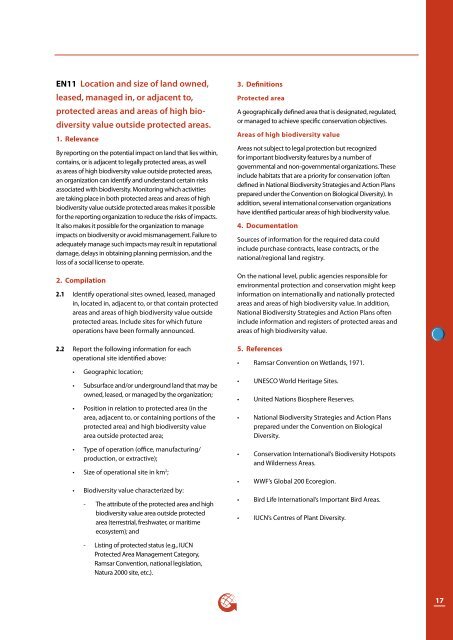Event Organizers Sector Supplement - Global Reporting Initiative
Event Organizers Sector Supplement - Global Reporting Initiative
Event Organizers Sector Supplement - Global Reporting Initiative
Create successful ePaper yourself
Turn your PDF publications into a flip-book with our unique Google optimized e-Paper software.
EN11 Location and size of land owned,<br />
leased, managed in, or adjacent to,<br />
protected areas and areas of high biodiversity<br />
value outside protected areas.<br />
1. Relevance<br />
By reporting on the potential impact on land that lies within,<br />
contains, or is adjacent to legally protected areas, as well<br />
as areas of high biodiversity value outside protected areas,<br />
an organization can identify and understand certain risks<br />
associated with biodiversity. Monitoring which activities<br />
are taking place in both protected areas and areas of high<br />
biodiversity value outside protected areas makes it possible<br />
for the reporting organization to reduce the risks of impacts.<br />
It also makes it possible for the organization to manage<br />
impacts on biodiversity or avoid mismanagement. Failure to<br />
adequately manage such impacts may result in reputational<br />
damage, delays in obtaining planning permission, and the<br />
loss of a social license to operate.<br />
2. Compilation<br />
2.1 Identify operational sites owned, leased, managed<br />
in, located in, adjacent to, or that contain protected<br />
areas and areas of high biodiversity value outside<br />
protected areas. Include sites for which future<br />
operations have been formally announced.<br />
2.2 Report the following information for each<br />
operational site identified above:<br />
• Geographic location;<br />
• Subsurface and/or underground land that may be<br />
owned, leased, or managed by the organization;<br />
• Position in relation to protected area (in the<br />
area, adjacent to, or containing portions of the<br />
protected area) and high biodiversity value<br />
area outside protected area;<br />
• Type of operation (office, manufacturing/<br />
production, or extractive);<br />
• Size of operational site in km 2 ;<br />
• Biodiversity value characterized by:<br />
- The attribute of the protected area and high<br />
biodiversity value area outside protected<br />
area (terrestrial, freshwater, or maritime<br />
ecosystem); and<br />
3. Definitions<br />
Protected area<br />
A geographically defined area that is designated, regulated,<br />
or managed to achieve specific conservation objectives.<br />
Areas of high biodiversity value<br />
Areas not subject to legal protection but recognized<br />
for important biodiversity features by a number of<br />
governmental and non-governmental organizations. These<br />
include habitats that are a priority for conservation (often<br />
defined in National Biodiversity Strategies and Action Plans<br />
prepared under the Convention on Biological Diversity). In<br />
addition, several international conservation organizations<br />
have identified particular areas of high biodiversity value.<br />
4. Documentation<br />
Sources of information for the required data could<br />
include purchase contracts, lease contracts, or the<br />
national/regional land registry.<br />
On the national level, public agencies responsible for<br />
environmental protection and conservation might keep<br />
information on internationally and nationally protected<br />
areas and areas of high biodiversity value. In addition,<br />
National Biodiversity Strategies and Action Plans often<br />
include information and registers of protected areas and<br />
areas of high biodiversity value.<br />
5. References<br />
• Ramsar Convention on Wetlands, 1971.<br />
• UNESCO World Heritage Sites.<br />
• United Nations Biosphere Reserves.<br />
• National Biodiversity Strategies and Action Plans<br />
prepared under the Convention on Biological<br />
Diversity.<br />
• Conservation International’s Biodiversity Hotspots<br />
and Wilderness Areas.<br />
• WWF’s <strong>Global</strong> 200 Ecoregion.<br />
• Bird Life International’s Important Bird Areas.<br />
• IUCN’s Centres of Plant Diversity.<br />
- Listing of protected status (e.g., IUCN<br />
Protected Area Management Category,<br />
Ramsar Convention, national legislation,<br />
Natura 2000 site, etc.).<br />
17

















